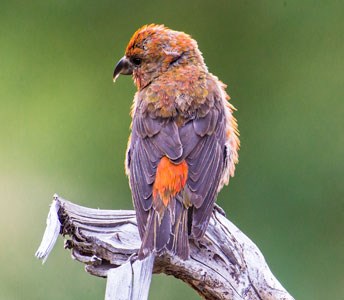
NPS/Ann Schonlau Loxia curvirostraLength: 5.8-6.4 in (14-16 cm) - Weight: 1.1-1.5 oz (31-42 g) General DescriptionRed Crossbills are finches with highly specialized, crossed bills and long, pointed wings. Male Red Crossbills are brick-red with black wings and no white wing-bars. Females are greenish-yellow with black wings and no wing-bars. Juveniles are streaked brown. The bill size of Red Crossbills varies considerably and correlates with distinct habitat and food preferences as well as flight calls. These characteristics can be used to split Red Crossbills into eight distinct types, and it is likely that the species will be divided into multiple species in the future. HabitatRed Crossbills typically inhabit mature conifer forests, and different types tend to specialize on preferred trees, including western hemlock, Ponderosa pine, lodgepole pine, Sitka, and Engleman spruce. BehaviorRed Crossbills are usually found in small flocks year round. They typically climb in mature conifers, using their bills to grab branches and cones. They will also occasionally land on deciduous trees and forage for aphids. Their bills are adapted for removing seeds from cones, and they start at the bottom of a cone and spiral upward, prying open each scale and removing the seeds with their tongues. The bills can cross in either direction, and the direction of the cross dictates the direction that the bird spirals up the cone. DietConifer seeds make up the main diet of Red Crossbills. They also eat the buds of some trees, weed seeds, berries, and some insects, especially aphids. NestingThe breeding cycle of Red Crossbills is more closely tied to food availability than it is to season. They can breed at almost any time of year, and will do so even in mid-winter if there is an abundant source of seeds.p> They are monogamous, and pairs form within flocks. The female builds the nest, which is located on a horizontal branch high up in a conifer tree. The nest is a bulky cup of loose twigs, grass, and bark strips, lined with fine grass, lichen, feathers, and hair. Eggs & IncubationRed Crossbill eggs generally are blush white with brownish red markings. The female typically incubates three eggs for 12 to 16 days. The male brings food to the incubating female and to the young for the first few days after they hatch. After five days of continuous brooding, the female joins the male in bringing food to the young. The young leave the nest after 18 to 22 days. The parents continue to feed the young for about a month after they hatch. The bills of young birds are not crossed at hatching, but cross as they grow. By 45 days they are crossed enough for the young to extract seeds from cones. Migration StatusRed Crossbills are nomadic and congregate in areas with high levels of cone production. They are non-migratory birds but occasional irruptions can occur in years when food is less abundant. Interesting Facts
|
Last updated: May 4, 2018
